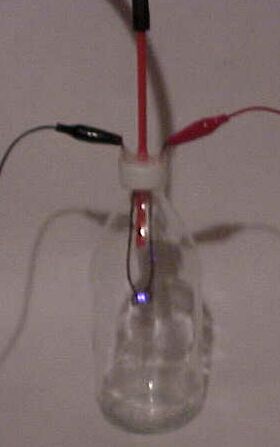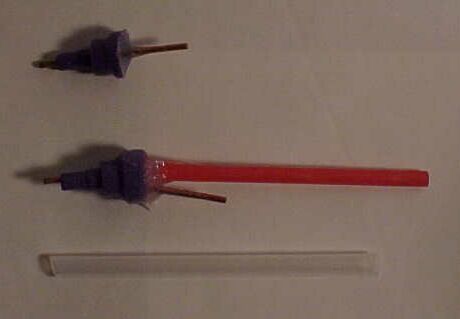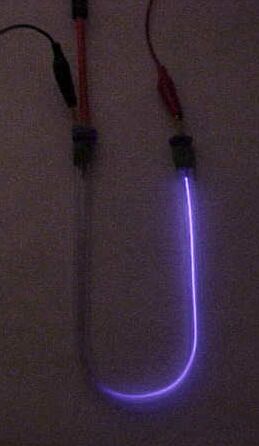
Shown above is a picture of the bottle electric discharge tube. Because of the small size of the cap, it is hard to make an arc larger than 1 inch.
The tube needs to be strong enough to hold in the vacuum. Test it by squeezing it. If it caves in easily you will need to find another tube. It can be made of glass, plastic, or anything else air tight and strong, and preferably clear (you want to be able to see it). You can even use a glass bottle. And if you like, use a colored tube, for a different colored discharge. But be careful that the tube can withstand the temperature of the arc, so it won't melt.
You will need some type of a vacuum to evacuate the air in the tube. It does not need to be a real big and expensive vacuum pump, but the higher the vacuum (lower the pressure) the better. If you are in need of a vacuum pump, but don't have a lot of money, using a refrigerator compressor in reverse should work well enough for most applications. You can also pass air or water through the 180° part of a T-connector, and get a vacuum at the 90° tap. You can also find vacuum hand pumps used for air conditioning at most automotive stores and Sears for about $40.00 U.S.
The power supply you need to use depends on the size and pressure of the tube. The farther the electrodes are away from one another, and the lower the vacuum (higher the pressure), the higher the voltage you will need to run the tube. You should also use a supply that is low in current or current limited, or the tube will get very hot, and may even start to melt. One of the ignition coil high voltage generators will work fine for some tubes.
These tubes won't be as efficient as commercial tubes, because they have better vacuum pumps, the purity of the gasses is much better, they use mercury vapor, etc... But I wouldn't try putting mercury in any of these tubes, because mercury is extremely poisonous, and I think that it is a carcinogen (it can cause cancer). I remember seeing on the news they had to evacuate a town after some teenagers were playing with mercury from an abandoned neon sign factory, and stored a few bottles of it in their barn.
First, stick a wire in one end of the tube and then put some silicone sealant around it to create an air tight seal. Then poke a hole somewhere in the middle of the tube for the other electrode to go into, and put some sealant around that. Once it is dry, pump out the air at the open end of the tube, attach the power supply to the electrodes, and try it out.
First attach the vacuum to the tube on the cap, and the power supply to the wires. Start to pump out the air, and then turn on the supply. You can bend the wires to be closer or farther apart, and see what happens.

Shown above is a picture of the bottle electric discharge tube. Because of the small size
of the cap, it is hard to make an arc larger than 1 inch.
First, take off the connector part of the pump, and cut off the extra plastic on the connector (you only need the part where it connects to the tube, not the whole thing. Cut it so that it has about 1/4" of the large section). One of the electrodes will have just the electrode, and the other will have the electrode and a tube for pumping out the air. To make the one that is only an electrode, stick a piece of wire through the connector so that a little of the wire sticks out of the end that will be inside the tube, and put silicone sealant all around it at the other end. To make the other, it is made the same way as the other, but you will have a tube in there as well. You just put a tube in the connector, and when you put sealant around everything, you just need to make sure that there is a path for air to flow through the connector part that is inserted into the tube, and the tube that goes to the vacuum pump.
When the sealant is dry, connect the electrodes to both ends of the tube, pump out the air, connect the power supply to the electrodes. If you are going to fill it up with some kind of gas, I suggest making two of the electrodes with tubes, so one can go to the vacuum pump, and the other to the gas supply.

The different parts of the discharge tube are shown above. The two electrodes, one of
which has the tube to pump out the air, and the clear tube.


The two pictures shown above are the discharge tubes using the ends of bottle pumps in
operation.
With some of these tubes, you can pump them up with air to get a different effect. I went up to 50psi on the bottle type, but stopped there. I wasn’t sure if it would explode or not if I went any further. I found that it takes a higher voltage to run higher pressure tubes, but the arc is much brighter. You could also try filling these tubes up with different gasses, and see what happens to the arcs color, size, etc... Using air the discharge will be a purple color from the nitrogen in the air. Helium and neon should produce a red or orange glow.